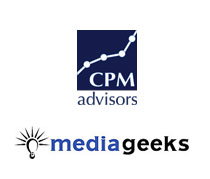 Demand-side platform CPM Advisors announced that it would be leveraging the technology infrastructure of publisher optimizer, Mediageeks. Read the release.
Demand-side platform CPM Advisors announced that it would be leveraging the technology infrastructure of publisher optimizer, Mediageeks. Read the release.
AdExchanger.com discussed the announcement with CPM Advisors CEO Rob Leathern and MediaGeeks GM Jacob LeWinter.
AdExchanger.com: It’s interesting that a demand-side tech company is partnering with a publisher-side technology company – and beyond just buying media through aggregators (yield optimizers). What’s the takeaway here?
Rob Leathern: The smart players in this space are the ones that can build valuable core technologies but also work with other providers who can help support those efforts with relevant technologies. It’s all about driving ROI for the advertiser, using cost-effective best-of-breed technologies that can help support that and not reinventing the wheel. Ad- and data-serving for us is about having the quickest, cost-effective, most efficient delivery infrastructure that can support our key assets in advertiser interface, decisioning, campaign data and budget management, and optimization.
Jacob LeWinter: As Mediageeks built out our global infrastructure we realized our services and technology were beneficial to more than just enterprise websites, and mediageeks evolved to be a leading ad infrastructure company. We now work with publishers, media companies, data platforms, DSPs, and even other supply side platforms who want robust scalable ad technology and solutions. We plan to work with the major players in each of these areas.
Mediageeks has been working with publishers but has not been as well-known as some of the other aggregators – why not?
Jacob LeWinter: Most clients white-label mediageeks’ technology and traditionally we have only worked with very large media companies. Mediageeks now serves billions of impressions and pixels, and this continues to grow each day. We’re like a utility company of the ad industry. We provide the framework, but its up to media companies to think of innovative ways to utilize us beyond just ad serving. CPM Advisors has pushed the boundaries of what can be done with smart ad serving.
“Blazing fast ad tags” – what’s that? Can you quantify and why is this important?
Rob Leathern: This is important for us since real-time bidding creates new cost parameters for serving and for bidding on inventory and our agencies and advertiser clients deserve non-legacy purpose-built systems to realize the efficiencies possible here. We have been building a brand new kind of data/creative serving system on top of the Mediageeks’ infrastructure that will make impression-level advertising an ROI-positive reality.
Jacob LeWinter: Mediageeks infrastructure allows for ad tags faster than most major ad servers including Dart or Atlas. Latency is a growing issue in the industry with websites placing far too many untested pixels and tags across their sites, which leads to frustrated end-users, not to mention lost revenue. 100% uptime and speedy tags are critical to an enterprise business. Because we built our infrastructure from the ground up, our system is blazing fast. And a fast, efficient infrastructure allows a company like CPM Advisors to do real-time targeting across multiple data criteria in an economical way for end clients.
Are there any special technical complexities to growing a self-service platform, such as CPM Advisors, as opposed to a platform with a full-service front end?
Rob Leathern: Our technology makes large-scale display advertising accessible and efficient for advertisers of all sizes by simplifying the process and improving the results. We’re not looking to give advertisers a Star Trek-type of media buying console: besides, it then entails teaching people yet another system. We spend a lot of time thinking of how we can compress the time it takes to handle mundane tasks like create and receive conversion tags, upload hundreds of flash or HTML ads, and build campaigns. We have had advertisers using our system and telling us what they like and don’t like and we continually change to react to their feedback. Understanding what information is necessary and what is not. And being able to do that at scale means having a smart inbetween layer that configures campaigns optimally based on target parameters, category, audience and so on. We think that automating the advertising process is achievable for both small and large advertisers alike.
By John Ebbert













